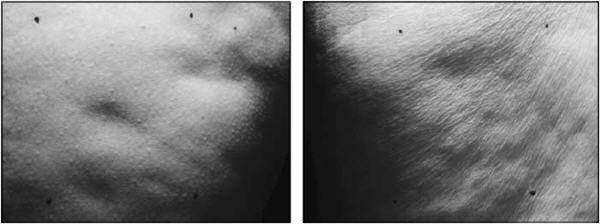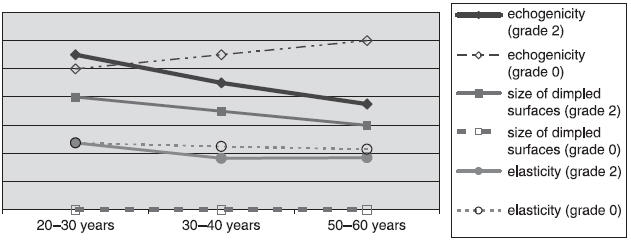The following picture contrasts the looks of cellulite in a young woman with that in a middle-aged woman.
Fig 1. Cellulite in a young woman (age between 21 – 30) and a middle-aged woman (age between 51 – 60); back of the thigh.
In younger women, the dimpled surfaces are larger and fewer in number. Fig. 1 is a good reason why it is helpful to treat cellulite. But is there an interaction between cellulite and aging? Ortonne et al.(1, pdf) investigated this question by assessing women, ages 21 – 60, with or without cellulite. The results, for the skin of the thigh, are shown in Fig. 2.
Fig 2. Changes in skin parameters with age as a function of the presence or absence of cellulite. See text for explanation.
The echogenicity of the dermis is an ultrasound measure of the density of the dermis (a skin layer). As one ages, collagen decreases in the skin, making it less dense, but this effect is especially observable after age 60, which the authors didn’t study. In Fig. 2 it looks likes the dermis is becoming denser with age in women without cellulite, but this is a sampling issue or a methodological issue that is addressed in the article. The interpretation should be taken as good stability of dermal density in the cellulite-free women, whereas the dermis becomes less dense with age in women with cellulite.
Note also that cellulite-free women retain skin elasticity better with age. The extent of wrinkling was unrelated to whether the women had cellulite or not.
In the women with cellulite, the total skin thickness was greater but the minimal thickness of the skin was lower because the hypodermis (layer just below the dermis) was pushed up into the dermis, presumably by the fatter fat cells lying just beneath the skin surface.
Whereas this is not a longitudinal study, i.e., a study where participants are followed as they age, it is quite likely that cellulite is associated with premature aging of the skin on some measures. So is there a non-cosmetic reason to treat cellulite? Possibly.
References
- Ortonne, J. P., Zartarian, M., Verschoore, M., Queille-Roussel, C., and Duteil, L., Cellulite and skin ageing: is there any interaction?, J Eur Acad Dermatol Venereol (2008), doi:10.1111/j.1468-3083.2007.02570.x.

